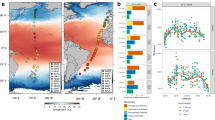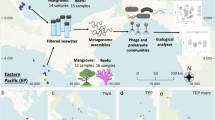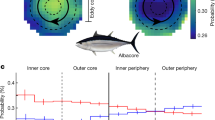Abstract
To investigate the effects of mesoscale eddies on prokaryotic assemblage structure and activity, we sampled two cyclonic eddies (CEs) and two anticyclonic eddies (AEs) in the permanent eddy-field downstream the Canary Islands. The eddy stations were compared with two far-field (FF) stations located also in the Canary Current, but outside the influence of the eddy field. The distribution of prokaryotic abundance (PA), bulk prokaryotic heterotrophic activity (PHA), various indicators of single-cell activity (such as nucleic acid content, proportion of live cells, and fraction of cells actively incorporating leucine), as well as bacterial and archaeal community structure were determined from the surface to 2000 m depth. In the upper epipelagic layer (0–200 m), the effect of eddies on the prokaryotic community was more apparent, as indicated by the higher PA, PHA, fraction of living cells, and percentage of active cells incorporating leucine within eddies than at FF stations. Prokaryotic community composition differed also between eddy and FF stations in the epipelagic layer. In the mesopelagic layer (200–1000 m), there were also significant differences in PA and PHA between eddy and FF stations, although in general, there were no clear differences in community composition or single-cell activity. The effects on prokaryotic activity and community structure were stronger in AE than CE, decreasing with depth in both types of eddies. Overall, both types of eddies show distinct community compositions (as compared with FF in the epipelagic), and represent oceanic ‘hotspots’ of prokaryotic activity (in the epi- and mesopelagic realms).
Similar content being viewed by others
Log in or create a free account to read this content
Gain free access to this article, as well as selected content from this journal and more on nature.com
or
References
Alonso-González IJ, Arístegui J, Lee C, Calafat A . (2009). Regional and temporal variability of sinking organic matter in the subtropical northeast Atlantic Ocean: a biomarker diagnosis. Biogeosciences, Discussion 6: 11089–11126.
Alonso-Saéz L, Gasol JM, Aristegui J, Vilas JC, Vaqué D, Duarte CM et al. (2007). Large-scale variability in surface bacterial carbon demand and growth efficiency in the subtropical northeast Atlantic Ocean. Limnol Oceanogr 52: 533–546.
Amann RI, Binder BJ, Olson RJ, Chisholm SW, Devereux R, Stahl DA . (1990). Combination of 16 rRNA-targeted oligonucleotide probes with flow cytometry for analyzing mixed microbial populations. Appl Environ Microbiol 56: 1919–1925.
Arístegui J, Barton ED, Montero MF, Garcia-Muñoz M, Escánez J . (2003). Organic carbon distribution and water column respiration in the NW Africa-Canaries Coastal Transition Zone. Aquat Microb Ecol 33: 289–301.
Arístegui J, Montero MF . (2005). Temporal and spatial changes in plankton respiration and biomass in the Canary Islands region: the effect of mesoscale variability. J Mar Syst 54: 65–82.
Arístegui J, Tett P, Hernández-Guerra A, Basterretxea G, Montero MF, Wild K et al. (1997). The influence of island-generated eddies on chlorophyll distribution: a study of mesoscale variation around Gran Canaria. Deep Sea Res 44: 71–96.
Azam F, Fenchel T, Field JG, Gray JS, Meyer-Reil LA, Thingstad F . (1983). The ecological role of water-column microbes in the sea. Mar Ecol Prog Ser 10: 257–263.
Baltar F, Arístegui J, Gasol JM, Hernández-León S, Herndl GJ . (2007). Strong coast—ocean and surface—depth gradients in prokaryotic assemblage structure and activity in a coastal transition zone region. Aquat Microb Ecol 50: 63–74.
Baltar F, Arístegui J, Montero MF, Espino M, Gasol JM, Herndl GJ . (2009). Mesoscale variability modulates seasonal changes in the trophic structure of nano- and picoplankton communities across the NW Africa-Canary Islands transition zone. Prog Oceanogr 83: 180–188.
Benitez-Nelson CR, Bidigare RR, Dickey TD, Landry MR, Leonard CL, Brown SL et al. (2007). Mesoscale eddies drive increased silica export in the Subtropical Pacific Ocean. Science 316: 1017–1021.
Bode A, Barquero S, Varela M, Braun JA, de Armas D . (2001). Pelagic bacteria and phytoplankton in oceanic waters near the Canary Islands in summer. Mar Ecol Prog Ser 209: 1–17.
Cheney RE, Richardson PL . (1976). Observed decay of a cyclonic Gulf Stream ring. Deep Sea Res 23: 143–155.
Daims H, Bruhl A, Amann R, Schleifer KH, Wagner M . (1999). The domain-specific probe EUB338 is insufficient for the detection of all bacteria: developments and evaluation of a more comprehensive probe set. Syst Appl Microbiol 22: 434–444.
De Corte D, Yokokawa T, Varela MM, Agogué H, Herndl GJ . (2009). Spatial distribution of Bacteria and Archaea and amoA gene copy numbers throughout the water column of the Eastern Mediterranean Sea. ISME J 3: 147–158.
del Giorgio PA, Gasol JM . (2008). Physiological structure and single-cell activity in marine bacterioplankton. In: Kirchman DL (ed). Microbial Ecology of the Ocean, 2nd edn, Wiley-Liss: New York. pp 243–298.
Ducklow HW . (1988). Bacterial biomass in warm-core Gulf Stream ring 82-B: mesoscale distributions, temporal changes and production. Deep Sea Res 33: 1789–1812.
Elser JJ, Marzolf ER, Goldman CR . (1990). Phosphorus and nitrogen limitation of phytoplankton growth in the freshwaters of North Ameria: a review and critique of experimental enrichments. Can J Fish Aquat Sci 47: 1468–1477.
Elser JJ, Stabler LB, Hassett RP . (1995). Nutrient limitation of bacterial growth and rates of bacterivory in lakes and oceans: a comparative study. Aquat Microb Ecol 9: 105–110.
Ewart CS, Meyers MK, Wallner ER, McGillicuddy Jr DJ, Carlson CA . (2008). Microbial dynamics in cyclonic and anticyclonic mode-water eddies in the northwestern Sargasso Sea. Deep Sea Res II 55: 1334–1347.
Falcioni T, Papa S, Gasol JM . (2008). Evaluating the flow-fytometric nucleic acid double-staining protocol in realistic rituations of planktonic bacterial death. Appl Environ Microb 74: 1767–1779.
Falkowsky PG, Ziemann DA, Kolber DA, Bienfang PK . (1991). Role of eddy pumping in enhancing primary production in the ocean. Nature 352: 55–58.
Fisher MM, Triplett EW . (1999). Automated approach for ribosomal intergenic spacer analysis of microbial diversity and its application to freshwater bacterial communities. Appl Environ Microbiol 65: 4630–4636.
Floodgate GD, Fogg GE, Jones DA, Lochte K, Turley CM . (1981). Microbiology and zooplankton activity at a front at Liverpool Bay. Nature 240: 133–136.
Gasol JM, Alonso-Sáez L, Vaqué D, Baltar F, Calleja ML, Duarte CM et al. (2009). Mesopelagic prokaryotic bulk and single-cell heterotrophic and community composition in the NW Africa-Canary Islands coastal-transition zone. Prog Oceanogr 83: 189–196.
Gasol JM, Zweifel UL, Peters F, Fuhrman JA, Hagström Å . (1999). Significance of size and nucleic acid content heterogeneity as measured by flow cytometry in natural planktonic bacteria. Appl Environ Microbiol 65: 4475–4483.
González JM, Simó R, Massana R, Covert JS, Casamayor EO, Pedrós-Alió C et al. (2000). Bacterial community structure associated with a dimethylsulfoniopropionate-producing North Atlantic algal bloom. Appl Environ Microbiol 66: 4237–4246.
González N, Anadón R, Mouriño B, Fernández E, Sinha B, Escánez J et al. (2001). The metabolic balance of the planktonic community in the North Atlantic subtropical gyre: the role of mesoscale instabilities. Limnol Oceanogr 46: 946–952.
Gregori G, Citterio S, Ghani A, Labra M, Sgorbati S, Brown S et al. (2001). Resolution of viable and membrane-compromised bacteria in freshwater and marine waters based on analytical flow cytometry and nucleic acid double staining. Appl Environ Microbiol 67: 4662–4670.
Harris RP, Boyd P, Harbour DS, Head RN, Pingree RD, Pomroy AJ . (1997). Physical, chemical and biological features of a cyclonic eddy in the region of 61° 10′N 19° 50′W in the North Atlantic. Deep Sea Res I 11: 1815–1839.
Hernández-León S, Gómez M, Pagazaurtundua M, Portillo-Hahnefeld A, Montero I, Almeida C . (2001). Vertical distribution of zooplankton in Canary Island waters: implication for export flux. Deep Sea Res I 48: 1071–1092.
Herndl GJ, Reinthaler T, Teira E, Aken Hv, Veth C, Pernthaler A et al. (2005). Contribution of Archaea to total prokaryotic production in the deep Atlantic Ocean. Appl Environ Microbiol 71: 2303–2309.
Hewson I, Fuhrman JA . (2004). Richness and diversity of bacterioplankton species along an estuarine gradient in Moreton Bay, Australia. Appl Environ Microbiol 70: 3425–3433.
Kelly KM, Chistoserdov AY . (2001). Phylogenetic analysis of the succession of bacterial communities in the Great South Bay (Long Island). FEMS Microbiol Ecol 35: 85–95.
Klausmeier CA, Litchman E, Daufresne T, Levin SA . (2004). Optimal nitrogen-to-phosphorus stoichiometry of phytoplankton. Nature 429: 171–174.
Letelier RM, Karl DM, Abbott MR, Flament P, Freilich M, Lukas R et al. (2000). Role of late winter mesoscale events in the biogeochemical variability of the upper water column of the North Pacific Subtropical Gyre. J Geophys Res Oceans 105: 28723–28739.
Lochte K, Pfannkuche O . (1987). Cyclonic cold-core eddy in the eastern North Atlantic. II. Nutrients, phytoplankton and bacterioplankton. Mar Ecol Prog Ser 39: 153–164.
Maiti K, Benitez-Nelson CR, Rii Y, Bidigare R . (2008). The influence of a mature cyclonic eddy on particle export in the lee of Hawaii. Deep Sea Res II 55: 1445–1460.
Massana R, Murray AE, Preston CM, DeLong EF . (1997). Vertical distribution and phylogenetic characterization of marine planktonic Archaea in the Santa Barbara Channel. Appl Environ Microbiol 63: 50–56.
Mathis JT, Pickart RS, Hansell DA, Kadko D, Bates NR . (2007). Eddy transport of organic carbon and nutrients from the Chukchi Shelf: impact on the upper halocline of the western Arctic Ocean. J Geophys Res 112: C05011.
McGillicuddy Jr DJ, Robinson AR, Siegel DA, Jannasch HW, Johnson R, Dickey TD, et al. (1998). Influence of mesoscale eddies on new production in the Sargasso Sea. Nature 394: 263–266.
Moeseneder MM, Arrieta JM, Muyzer G, Winter C, Herndl GJ . (1999). Optimization of terminal-restriction fragment length polymorphism analysis for complex marine bacterioplankton communities and comparison with denaturing gradient gel electrophoresis. Appl Environ Microbiol 65: 3518–3525.
Moeseneder MM, Winter C, Arrieta JM, Herndl GJ . (2001). Terminal restriction fragment length polymorphism (T-RFLP) screening of a marine archaeal library to determine the different phylotypes. J Microbiol Meth 44: 159–172.
Morán XAG, Taupier-Letage I, Vázquez-Domínguez E, Ruiz S, Arin L, Raimbault P et al. (2001). Physical-biological coupling in the Algerian Basin (SW Mediterranean): influence of mesoscale instabilities on the biomass and production of phytoplankton and bacterioplankton. Deep Sea Res I 48: 405–437.
Mouriño-Carballido Jr B, McGillicuddy DJ . (2006). Mesoscale variability in the metabolic balance of the Sargasso Sea. Limnol Oceanogr 51: 2675–2689.
Pomeroy LR, Atkinson LP, Blanton JO, Campbell WB, Jacobsen TR, Kerrick KH et al. (1983). Microbial distribution and abundance in response to physical and biological processes on the continental shelf of southeastern USA. Cont Shelf Res 2: 1–20.
Smith DC, Azam F . (1992). A simple, economical method for measuring bacterial protein synthesis rates in seawater using 3H-leucine. Mar Microb Food Webs 6: 107–114.
Sommer U . (1994). The impact of light intensity and day length on silicate and nitrate competition among marine phytoplankton. Limnol Oceanogr 39: 1680–1688.
Tarran GA, Zubkov MV, Sleigh MA, Burkill PH, Yallop M . (2001). Microbial community structure and standing stocks in the NE Atlantic in June and July of 1996. Deep Sea Res II 48: 963–985.
Teira E, Reinthaler T, Pernthaler A, Pernthaler J, Herndl GJ . (2004). Combining catalyzed reporter deposition-fluorescence in situ hybridization and microautoradiography to detect substrate utilization by Bacteria and Archaea in the deep ocean. Appl Environ Microbiol 70: 44411–44414.
Thingstad TF, Zweifel UL, Rassoulzadegan F . (1998). P limitation of heterotrophic bacteria and phytoplankton in the northwest Mediterranean. Limnol Oceanogr 43: 88–94.
Thyssen M, Lefevre D, Caniaux G, Ras J, Fernandez CI, Denis M . (2005). Spatial distribution of heterotrophic bacteria in the northeast Atlantic (POMME study area) during spring 2001. J Geophys Res 110: C07S16, doi:10.1029/2004JC002670.
van der Maarel MJEC, Artz RRE, Haanstra R, Forney LJ . (1998). Association of marine Archaea with the digestive tracts of two marine fish species. Appl Environ Microbiol 64: 2894–2898.
van Haren H, Millot C, Taupier-Letage I . (2006). Fast deep sinking in Mediterranean eddies. Geophys Res Lett 33: L04606:10.1029/2005GL025367.
Yebra L, Almeida C, Hernández-León S . (2005). Vertical distribution of zooplankton and active flux across an anticyclonic eddy in the Canary Island waters. Deep Sea Res I 52: 69–83.
Zhang Y, Sintes E, Chen J, Zhang Y, Dai M, Jiao N et al. (2009). Role of mesoscale cyclonic eddies in the distribution and activity of Archaea and Bacteria in the South China Sea. Aquat Microb Ecol 56: 65–79.
Acknowledgements
This research was supported by two grants of the Spanish Ministry of Education and Science to JA (Oceanic Eddies and Atmospheric Deposition—RODA, CTM 2004-06842-C03/MAR, and Shelf–Ocean Exchanges in the Canaries–Iberian Large Marine Ecosystem-CAIBEX, CTM 2007-66498-C02), a grant of the Earth and Life Science Division of the Dutch Science Foundation (ALW-NWO; ARCHIMEDES project, 835.20.023) to GJH, and a predoctoral Fellowship of the Spanish Ministry of Education and Science (AP2005-3932) to FB. IL and JMG were also supported by project MODIVUS (CTM2005-04795/MAR). The work was carried out within the frame of the EU ‘Networks of Excellence’ MarBef and EurOceans. We acknowledge the insightful comments of two anonymous reviewers, which helped to improve the manuscript. We thank the captain and crew of R/V Hespérides for their help during work at sea. We also thank A Marrero-Díaz for providing the temperature cross-sections, and AM Caballero-Alfonso for her help during sampling and DNA extraction.
Author information
Authors and Affiliations
Corresponding author
Rights and permissions
About this article
Cite this article
Baltar, F., Arístegui, J., Gasol, J. et al. Mesoscale eddies: hotspots of prokaryotic activity and differential community structure in the ocean. ISME J 4, 975–988 (2010). https://doi.org/10.1038/ismej.2010.33
Received:
Revised:
Accepted:
Published:
Issue date:
DOI: https://doi.org/10.1038/ismej.2010.33
Keywords
This article is cited by
-
Dynamics in Bacterial Community Affected by Mesoscale Eddies in the Northern Slope of the South China Sea
Microbial Ecology (2022)
-
Depth-Dependent Variables Shape Community Structure and Functionality in the Prince Edward Islands
Microbial Ecology (2021)
-
Bacterial community variations in the South China Sea driven by different chemical conditions
Ecotoxicology (2021)
-
Deep ocean metagenomes provide insight into the metabolic architecture of bathypelagic microbial communities
Communications Biology (2021)
-
Reducing the arbitrary: fuzzy detection of microbial ecotones and ecosystems – focus on the pelagic environment
Environmental Microbiome (2020)



